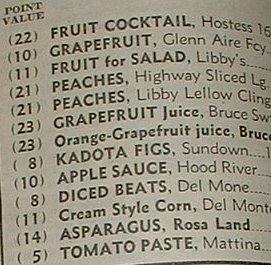| One of the things that members of that generation remember the most is the rationing system. This, when put in effect in February of 1942, was enacted to ensure that everyone had enough to eat and that the military had the supplies it needed. Rationed items fell into two categories, things that required a ration stamp and those that you simply could not get. Regardless of what category these items fell into, the nation and the residents of the Pend Oreille Valley took it all in stride and waited for life to get back to normal and looked forward to the time when they wouldn't have to concern themselves with ration stamps. |
|
Each person, regardless of age was issued a rationing book, a book that had to be used to purchase any rationed items, especially meats, fats, oils, butter, sugar, shoes, processed food (vegetables, fruits), and coffee. The ration books had color-coded stamps that were all a certain point value and that were valid only on those dates that corresponded to the letter on the stamp. The local newspaper kept a weekly account of which stamps were valid when, and for which goods, even the gasoline ration. The gasoline ration was governed by a separate coupon book, and depended on which type of coupon you were allowed to have depending on how many miles you drove, and what type of occupation you were in (A, B, C, T).
|
| Portable Lamps | Their Metal Pieces Used for Munitions |
| Coffee and Tea | All Spare Coffee and Tea Went into C-Rations |
| Vacuum Cleaners | The Metal needed for Munitions |
| Leather | Boots and Other Clothing Items |
| Fluorescent Lighting | Metal used for Munitions |
| Lumber for civilian building | All Lumber Used for Shipbuilding and Military Housing |
| Copper | Munitions, Wiring for Planes, Ships |
| Brass | Munitions |
| Steel | Shipbuilding, Tanks, Jeeps, Other Types of Military Vehicles |
| Spices | Reserved for Military Uses in C-Rations |
| Silk | Powder Sacks for Munitions |
| Nylon | Parachutes, Parachute tapes, Shroud Lines, Harness Webbings, Glider tow ropes |
| Rayon | Cords for Military Tires, Parachute Cords, Material Uniforms |
| Chocolate | Reserved for C-Rations |
| Rubber tires | Reserved for Military Uses |
| Gas and Fuel Oil | Reserved for Military Vehicles, Ships, Planes |
| Sugar | Reserved for C-Rations |
| Meat | Reserved for C-Rations, especially beef and pork |
| Fabric for clothing limited | Extra Material Used for Uniforms, Bandages |
| Reduction of elastic production by 50% | Extra elastic Used for Uniforms, etc. |
| All Metal Products (cans, caps, games) | All Metal Products Used by Military and Industry for War Production |
| Crude rubber and latex for hoses | Reserved for Industry, Military Production |
| Tires were rationed to save the rubber for the military, for their tires, hoses, air lines, etc. People on the homefront now had to go to their local ration board to petition for tires over their set allotment. Physicians, surgeons, police officers, visiting nurses, veterinarians, and mail carriers could easily get new passenger tires though. Essential industries such as the lumber mills and mines could also get new tires easier than those that had to petition the Ration Board. Regardless of the ease of getting tires, all those petitioning and buying tires, retreads or new, all had their names and amount of tires posted in the local newspaper. |
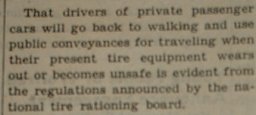 |
Announcements of tire rationing, Newport Miner
courtesy Pend Oreille County Historical Society |
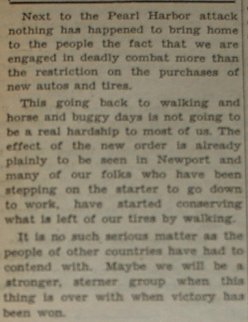   |
| Retread tires were an option when an individual or business went to get tires. This way, they were given a chance to save the new tires for the war effort, however, according to many interviewees, "retreads were worthless, it was almost better to go without." To not only save on gas, which was also rationed, the state placed speed restrictions on the highways, 35 mph for passenger cars, and 25 mph for trucks. |
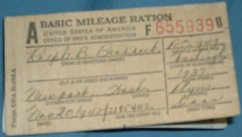 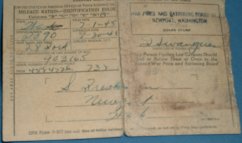 |
Milage Ration Books
courtesy Pend Oreille County Historical Society |
| The "A" gasoline ration coupons provided a monthly ration of 8 gallons, or approximately 120 miles a month per registered "A" car. In September 1944 the "A" coupon book contained coupons that were worth 4 gallons each instead of 3. Then six of these 4 gallon coupons became valid every three months, providing 24 gallons in each three month validity period for consumers. Along with every new gasoline coupon issued to consumers, they were required to have tire inspections to insure that they were taking care of their tires and thereby wouldn't require new tires before they were allowed to have them. |
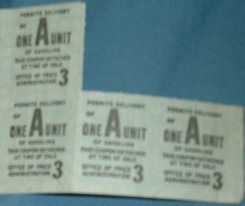 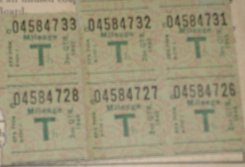 |
Gas Ration Stamps A and T
courtesy Pend Oreille County Historical Society |
| Pat Geaudreau We had two cars, a 1940 Chevrolet and a 1937 Ford. The Chevrolet had an "A" stamp on it, which had the most gallons a month, and the 1937 had a "B" stamp. Since there were other means of transportation, we put the cars up on blocks during the winter, and either rode the bus, the train, or walked. |
| The ration on gasoline however was to save on the consumption of rubber, a resource that the United States had to import, and since the Japanese now controlled many of the areas in which our rubber resources came from, the rubber needed for the military had to come from the homefront via rationing of tires and gasoline. Bob Rednour describes the trials of tire rationing, something that really affected this area, and its farmers. |
| When it was discovered that silk powder bags would not leave a residue inside gun barrels, the government began to ration silk. The much of the silk that was used in the United States at the time was in silk stockings, an item that was immediately rationed, causing many women to have to go without their stockings or go to using rayon stockings. Women were reminded to take special care of their stockings to make them last as long as possible and even encouraged to turn in stockings (either silk or rayon or a mix of both) that were worn out for the war effort. |
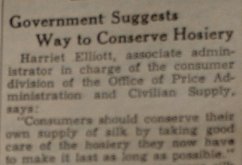 |
| Not only were silk stockings in high demand, but the new nylon stockings were as well. Nylon was especially prized by the military for paratrooper uniform pieces and harness webbings, glider tow ropes, parachutes, and parachute shroud lines. While nylon stockings were available to the public in 1938, very few women in the Pend Oreille Valley had them in the 1940s, as the stores here were still providing only silk or rayon. |
| Rayon was also needed for many of the things nylon was needed for: cords for military tires, cords for parachutes, material for paratroop uniforms, and lining for uniforms. However, while silk and nylon stockings drives were happening throughout the war, women were told that they need not turn in stockings made entirely of rayon as they were not wanted. The government instead received rayon directly from the manufacturers. |
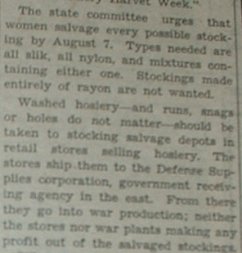 |
| The rationing of silk, nylon, and rayon caused many women to resort to using a special type of coloring lotion on their legs and to take an eyeliner pencil to draw a seam line up the back of their legs to make it appear they were wearing stockings. This saved the wear and tear on their stockings which were extremely difficult to buy, and that were not able to be purchased using a ration stamp. |
| Pat Geaudreau Whenever we went to Spokane we (my friends and I) would paint our legs to make them look like we had silk hose on, in fact we did it all the time. We would put this goop on our legs to make them look brown, then take a dark pencil and draw the "seam" up the back of our legs. Also, my mother had a pair of silk stockings, and someone came to her and asked her to donate them to nurses that were overseas. She of course told him no and held on to them. |
| Norma Rednour I only tried to paint my legs once, because they ended up blotchy, and if you didn't get the "seam" straight, then it looked ridiculous. I used a lot of rayon stockings instead of silk because the silk ones were expensive and didn't last, but rayon was a pain because they would snag and put great big holes in them. |
| Evelyn Reed ...and the stockings were not rationed, they just weren't available. If you saw a store that had nylons, there would be a line a block long and we wore rayon stockings, which were neat, when you'd stand up the knees would bag and so on. Well it looked a lot like liquid make up, facial make up, a little bit thinner I guess, you had different colors, and I don't know, I heard a lot of people saying you know, that it ran and so on, normally I only did it in the summertime, you know, it was too cold in the wintertime. I didn't play around with, some of 'em tried to paint, the stockings nearly all were seamed then, and some of them would try to paint the seams and stuff. I couldn't get my stocking seams straight half the time, I thought that was the best invention when they came up with seamless nylons. It was just, it was something that a lot of people did or didn't do. I don't think I know I didn't do it all the time, but if I was going someplace and especially in the summer when it was hot anyway, and I didn't want to wear those old rayon stockings and I think I had one or two pairs of nylons that I had saved for very, very special occasions. And silk stockings maybe if some people had a few silk stockings left, but I had nothing that hadn't worn out totally, so leg paint was a better alternative than white legs or something. Course we also tried to get our legs tan and that, but I never did have very much luck, I never laid out in the sun very much, it always made me a little kinda nauseated and so my tanning always happened just as I was doing activities outside and so on. |
| Helen Beaubier It was hard, hard going without nylon stockings and I remembered when we heard after the war was over and we heard that Penny's had, had nylon stockings and I, I ran outta the house and was gonna run down to the store and get nylons and I got a pair and they were thick and they wouldn't stay up, they were terrible [laugh] they were they were just awful those first nylons that came. Wasn't easy and at the time you had seams up the back of your legs you know the stockings all had seams up the back and you had to paint that line on there and it was hard to get that straight. I think I just did it when I wanted to get really duded up [laugh] |
| Rationing of meats, fats, butter, and oils began in 1943 with the issuance of Ration Book III. The stamps that were needed to purchase these products started out as red, then changed to brown with the issuance of Ration Book IV in 1944. This ration continued well after the war, finally being lifted in November 1945. The meat products ration mainly included beef and pork, as they were needed to feed the armed forces, and to ensure that there would be enough for everyone on the homefront. There were Meatless Tuesday's, where Americans, were asked to give up meat for one day, something that many Americans complied with. The grocery advertisement below, from early 1943 (before meat rationing began) shows the prices of meats during the early days of the war. Prices were frozen on all food items in 1942, so the prices you see here were standard for the war, until rationing was lifted in 1945. Note the plea to buy only what was needed
|
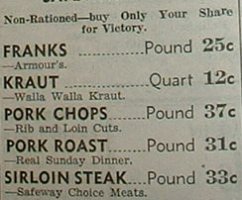 |
| Because of the meat ration, people on the home front had to rely on eating chicken, rabbit, wild game, and fish for their meats, due to the fact that not only was beef, pork, and lamb rationed, but it was also very expensive. |
| Bob Rednour All of the beef we raised had to be accounted for with the government and sold at Stockland, so we ate a lot of chicken and rabbit during the war, as my mother raised both. To this day I do not mind eating chicken, but I hate the taste of rabbit. |
| Norma Rednour Since meat was really expensive, I ended up eating a lot of chicken and rabbit, but I don't really mind eating rabbit now. I also was able to get pork from my parents since they had pigs.
|
| The rationing of coffee began as soon as the war started, so that the military and Americans on the homefront had enough coffee to last. All ration books (I-IV) contained coffee stamps limiting coffee consumption here at home. The coffee ration did not last the entire war, ending in 1945 much to the relief of coffee drinkers around America. Many from the Pend Oreille Valley traded for coffee stamps, and some panicked if their coffee stamps were misplaced on the way to the store. |
| Norma Rednour The coffee ration was a pain, because I liked my coffee. I would often trade stamps I didn't need to get extra coffee stamps. |
| Bob Rednour The coffee ration was hard for my folks, they would trade stamps with others in the area so that they could get their coffee. |
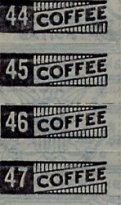 |
| Coffee Stamps, Ration Book III |
| The rationing of sugar began in 1942 and ended in 1945 ensuring again that there was enough sugar for the homefront and the military, and in fact was the first thing to be rationed in America. The sugar ration at first required all people to register to receive the first ration book of 28 stamps. Those that canned had to register every year for a bigger sugar allotment, showing what amounts were being canned, and specifically how much extra sugar they needed. However, many people got to the point that they were using very little sugar, even to bake because they were now substituting honey for sugar. The stamps in ration books for sugar were not point stamps as the meat and processed foods were, in most cases they were picture stamps (airplanes, etc.) with a number on them. |
| Norma Rednour I really didn't use a lot of sugar, so I gave most of my stamps to my mother because she did a lot of canning. |
| Bob Rednour Sugar was a pain, since you were only allowed so much sugar. You had to mix other things in with it to make it last such as honey, and we would trade stamps to get what we needed. |
| Joann Rahder And in our house we had sugar jars for each member of the family and we got one cup of sugar each week. Now that's a heck of a lot of sugar isn't it by today's standards? Anyway that was used for our cereal and anything else we had to put sugar on. But my mother had a deal where if we would save some sugar and had sugar left in our jar and the way she did it was we each had a colored topped like a sugar pourer like you see in the restaurants, they weren't metal then, they were plastic and we each had our own colored lid because there were three girls and my mother and father, so there was five of those. So we pooled the sugar at the end of the week before we poured more sugar in it, we pooled that sugar and we could make cake, pie, cookies or something like that. My mother had a wonderful recipe for eggless and milkless and butterless cake. It was absolutely delicious and she would back that often. For canning in the summer, the sugar left at the end of the week and then you put another cup in each person's jar and that sugar that was in reserve would be used for canning, so you know it was real frugal, my mother did a nice job of that. |
| Rationing of processed and canned goods that started in February 1943 was not only to make sure there was enough to go around but the metal containers these products came in were needed for the manufacture of tanks, planes, ships, guns, artillery shells, bullets, and other war products. Canned, bottled, and frozen fruits, vegetables, juices, and dried fruits and soups required blue or green stamps for their purchase. Even baby food containers needed the processed food ration stamps. |
 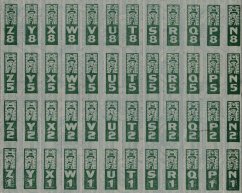 |
| Blue and Green Ration Stamps, Ration Books III and IV |
| Not only were ration stamps needed for rationed food items, but money was as well. To serve as change for items purchased with ration stamps, the OPA (Office of Price Administration) came up with tokens to serve this purpose. The tokens (below) were red and blue, and corresponded with the ration stamps you were using, and were worth 1 point each starting in February 1944. For example, purchase meat items with a red stamp, get a red token back as change or use one for payment. The same went with the blue tokens and blue/green stamps. |
 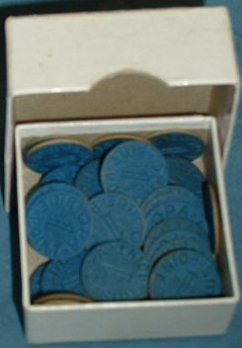 |
| courtesy Pend Oreille County Historical Society |
| Any containers that contained metal were rationed, such as shaving cream and toothpaste tins and tubes, razor blades, metal for children's games, catsup, jelly, and jam caps, and metal and glass in Christmas ornaments (especially tinsel). Because of the limited availability and often absence of these products, Americans now had plastic Victory Razors, children's games made of cardboard and wood,and Christmas ornaments of paper and spun glass. |
| Clothing was also stream-lined, to save in the amount of cloth available for uniforms. Women's belts were now 2 inches in width compared to 4 inches pre-war widths. Men's trouser cuffs were eliminated and even banned for the duration. Elastic for in women's girdles was reduced 50 percent. |
| Even the metal foil in cigarette packs was eliminated for the sake of war production |
| Beer and sodas were also rationed, the bulk of them were slated for the forces overseas, because of this, both were extremly hard to get. |
| Pat Geaudreau When the train carrying beer to be sent to the troops in the South Pacific derailed on the Idaho section of the Great Northern tracks here in town, the townspeople gathered up beer bottles and cans in gunnysacks. They then, including my brother, hid them in their houses so they didn't have to give the beer back. The whiskey car never broke open like the beer car did, but someone popped the lock and hauled out cases of whiskey. The beer was no big deal to lose, but people got in trouble and had to give the whiskey back though. |
| Shoes for many were the hardest thing to go without during rationing. Because the rubber for the shoe soles and the leather that made up the rest of the shoe was needed for war production, Americans were limited to 3 new pairs of shoes per year for each member of the family, however if a person worked in an essential industry, they were allowed to purchase rubber boots and rubber work shoes. The majority of Americans had to be content with wooden-soled and limited leather-upper shoes, or shoes made of canvas. The shoe stamp that was issued in Ration Book III was a black stamp with a mini-airplane in flight on it, a stamp that remained valid indefinitely. |
| Norma Rednour The shoe ration was a pain, since I had a passion for shoes. I owned throughout the war 45 pairs of shoes, all with different soles. There was really no rubber, so I had some with wooden and synthetic soles, and even some with wooden dowels on the sole. I would trade stamps so that I could get more shoe stamps. |
| Pat Geaudreau The shoe ration was hard, I liked horses, and wanted to buy a pair of cowboy boots really badly but I couldn't. I conned a friend of mine, John Olsen into giving me his shoe ration and I got my pair of cowboy boots. |
| Faith McClenny Well my mother went down to the store, it was called Sauter's and of course the shelves were bare and the clerk, I guess it was Mr. Sauter, said that if he had even shoe boxes, he could have even sold them. That it was so hard to get shoes and we just wore what we had, I being the oldest I didn't have, I couldn't wear anybody's leftovers. |
| Helen Beaubier Well you just accepted it, it was not easy. I mean you didn't get shoes every time you turned around. I mean you had to wait and I was lucky because Rick didn't have to have shoes for awhile and so I had two shoe stamps and that was neat |
| Joann Rahder we had Buster Brown shoes and penny loafers and shoes there was only enough stamps for a pair of shoes at the beginning of school and those had to last you until Easter, then you got a pair of Easter shoes and they had to last 'til school in the Fall. They were resoled and repaired. |
| Waste fats and grease were saved for the war effort, and turned into local collection points to be reclaimed as glycerine for gunpowder. Americans were urged to collect their waste fats and grease to make sure the fighting men had gunpowder, and save they did. Offers were made to provide 2 red ration points and 4 cents (red tokens) from their butcher for every for every pound of waste kitchen fats and grease Americans turned in. |
| Scrap iron was also saved for the war effort. Americans were encouraged to turn in all scrap metal to collection depots, enabling the metal to be reclaimed for war production factories. There would be frequent scrap metal drives in every community, with kids even getting into the act, pulling their wagons throughout town and collecting people's scrap metal. |
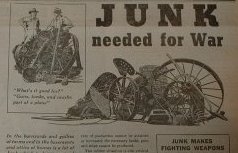 |
Scrap Metal Ad, Newport Miner
courtesy Pend Oreille County Historical Society |
| Joanne Rahder One of the first memories I have was that I had a red wagon and we collected scrap from the vacant lots. See we had lots and lots of vacant lots in our area you know we had some older homes and oh every once in awhile there'd be a house built but mainly not until after the war was over was a bunch of houses built. So the collection area then was the elementary school and because my mother and dad didn't have a car I think we kids pooled the stuff and took it over to the school 'cause we walked to the school with it all, in our little red wagon, kinda rusty red wagons [laugh]. And my dad had a collection out in his garage like all guys do and we asked him what we could take from his collection too, as I remember correctly. |
